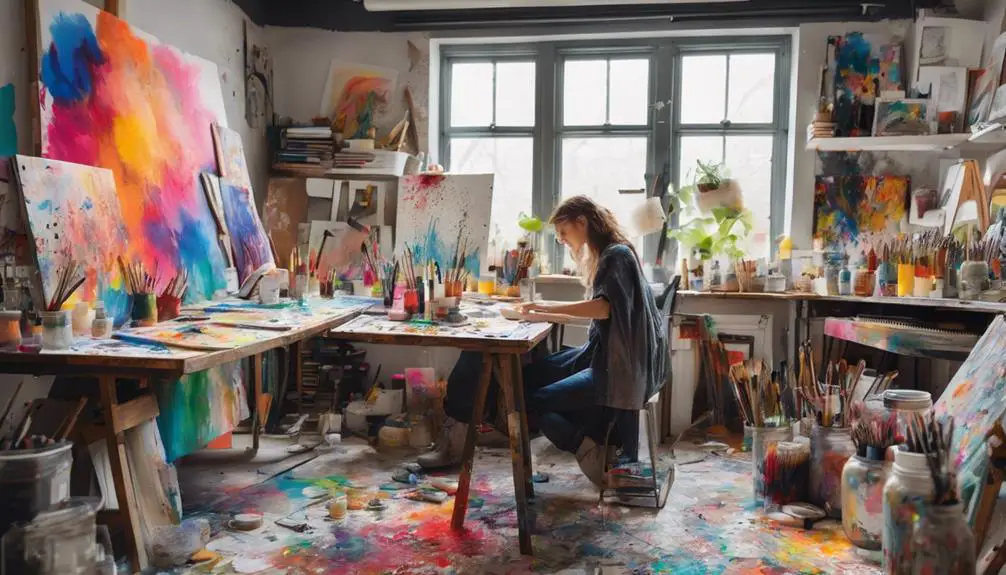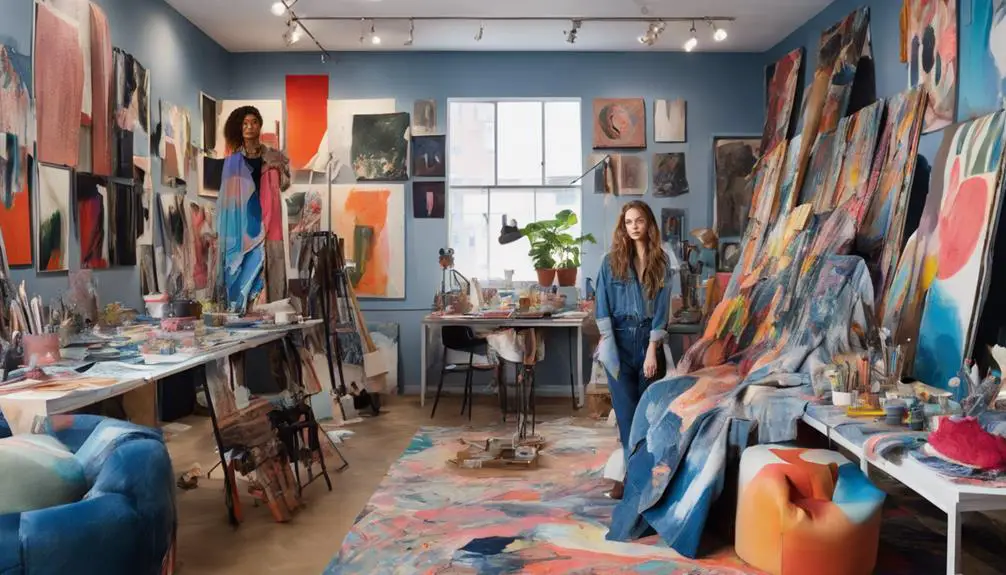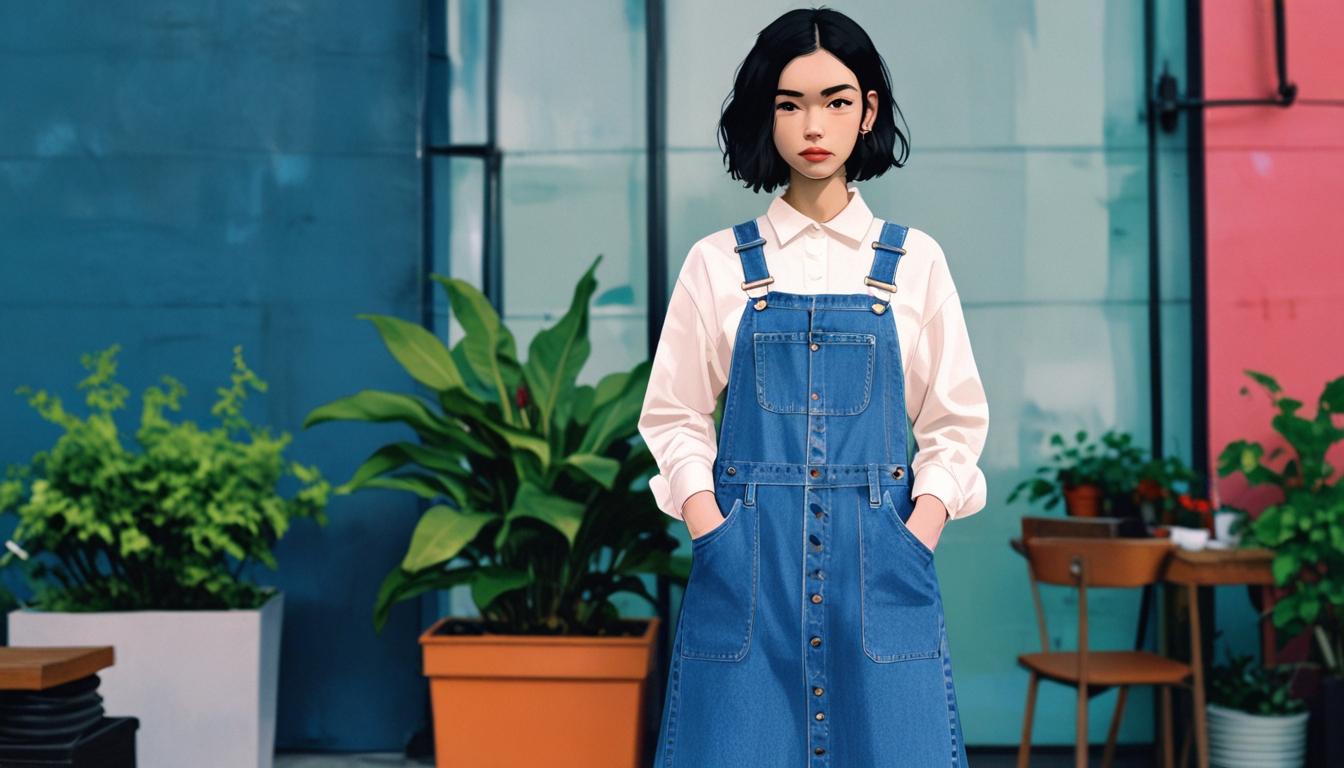You might not realize that art school fashion isn't just about looking good; it's a canvas for self-expression and creativity. While many think of typical student attire as casual and practical, the true essence lies in blending comfort with bold artistic choices. As you explore how to curate your wardrobe, consider the importance of layering and unique accessories that tell your story. What elements can transform your everyday outfit into a reflection of your artistic journey? Let's examine the key components that make art school fashion a crucial part of your creative experience.
Essential Art Supplies

When diving into the world of fashion illustration, having the right art supplies can make all the difference in your work. Think about it: you wouldn't bake a cake without the right ingredients, right? So, let's talk about the essentials for your fashion design journey.
First up, pencils! You'll want a mix of 2B mechanical pencils, 2B-6B soft graphite, and those fabulous Ebony pencils. They give you great shading without tearing your precious paper. Speaking of paper, go for a sketchbook that's at least 14×17 inches in landscape format. It's perfect for detailed sketches. A spiral-bound pad is great for quick ideas, too.
Now, let's chat about paper quality. Bristol vellum and watercolor paper are your best friends. Look for cold press or vellum surfaces for that extra texture that pops in your illustrations. When it comes to color, dry pan gouache is a must-have for fabric and skin rendering. Stick to neutrals, primary colors, and earthy tones for skin and hair.
And don't forget your brushes! Round, pointed synthetic watercolor brushes in sizes 8 to 10 will take your work to the next level. They have a great snap-back, making them ideal for that perfect stroke.
Finding Fashion Inspiration
Finding Fashion Inspiration
After you've gathered your art supplies, the next step is to find the inspiration that fuels your creativity in fashion illustration. So, where do you start? Social media platforms like Pinterest and Instagram are your best friends! Curate visual boards that reflect your personal style and check out emerging fashion trends. It's like a treasure hunt for ideas! You might also want to explore vintage pieces, as identifying vintage Ralph Lauren can provide a unique touch to your fashion illustrations and help you understand the evolution of style.
Don't forget about fashion blogs and online magazines. These places are full of editorial content showcasing innovative styles and outfit breakdowns. You'll discover new ways to put your wardrobe together, and who knows, you might stumble upon something straight out of art history that speaks to you!
Another great source of inspiration is street style. Hit the streets during fashion weeks or just explore your urban environment. Observe how individuals creatively mix and match pieces for unique looks. It's amazing what you can learn from just watching others.
Also, make sure to attend local fashion events, pop-up shops, or art exhibitions. These gatherings expose you to diverse aesthetics, and you can connect with fellow fashion enthusiasts. Plus, it's a fun way to get out and mingle!
Lastly, keep a dedicated sketchbook or use a digital app to document outfits and styles that resonate with you. This personalized library will be your go-to reference when developing your wardrobe. Remember, inspiration is everywhere, just waiting for you to grab it! Happy hunting!
Developing Personal Style

In the journey of developing your personal style, observational learning plays a crucial role. You can start by analyzing outfits around you—on the street, in your classes, or even on platforms like Pinterest. What colors catch your eye? Which accessories make you feel excited? Jot down those vibes that resonate with you. This helps you discover a broader range of styles that you might not have considered before. Consider incorporating tailored vintage pieces into your wardrobe, such as a tailored blazer or a unique vintage dress, to add character and depth to your outfits.
Don't be afraid to experiment! Trying out different aesthetics can be super fun. Step out of your comfort zone; you might find a unique preference that surprises you. Keeping a detailed list of your favorite wardrobe pieces, noting their fabric, fit, and color, can also guide your future shopping. Trust me, it'll save you from buying items that just hang in your closet.
Building a foundational wardrobe with versatile essentials is key. These basics make it easier to mix and match while you gradually add new items. This way, you'll build confidence in your personal style over time.
Engaging with fashion communities online or in-person can provide tons of support. Sharing your looks and seeking feedback helps you refine your style even more. Who knows? You might inspire someone else too! So, embrace this journey, have fun, and remember, your style is all about expressing who you are. Keep experimenting and enjoy the ride!
Strategies for Wardrobe Building
Building a well-curated wardrobe starts with a solid foundation of versatile essentials. You'll want to grab some basic tops, bottoms, and outerwear that you can mix and match for different looks. Think of it as creating your own fashion playground! Vintage clothing, particularly from the popular decades like the 1960s and 1970s, often offers unique pieces that can add character and history to your wardrobe. Make sure to choose items that can be dressed up or down, giving you endless outfit possibilities.
As you settle into your style, gradually introduce new pieces based on what you like and what works for you. Experimentation is key! Focus on quality over quantity—it's better to have a few well-made items than a closet full of stuff you never wear. When shopping, prioritize pieces that align with your personal style and can be worn in multiple ways. Trust me, your future self will thank you!
Keep a detailed list of your favorite clothing features and attributes. This is your secret weapon! It'll help guide your future purchases and reduce the chances of buying something that ends up sitting in the back of your closet.
And don't forget to regularly assess what works and what doesn't. Wardrobe evolution is natural, so make informed decisions about what to add next. Ask yourself, "Do I really love this?" If the answer is no, it's time to let it go. With these strategies, building a wardrobe that reflects your style becomes a fun adventure rather than a chore. So, are you ready to level up your wardrobe? Let's do this!
Community and Support Networks

Engaging with a vibrant community in fashion can elevate your creative journey to new heights. You don't have to go it alone—there's a whole world of support waiting for you! Joining fashion-focused groups or forums is a fantastic way to connect with fellow artists. Imagine sharing insights and techniques, learning from each other's experiences, and cheering each other on. That's what community is all about!
Participating in local or online workshops not only boosts your skills but also helps you make friendships with other aspiring designers and illustrators. It's like a creative playground where you can collaborate and grow together. Plus, don't underestimate the power of mentorship! Many fashion communities offer opportunities to work with seasoned pros who can guide you, giving you personalized advice and accountability.
And let's not forget about resource pages dedicated to fashion education. They're gold mines for inspiration and networking. You'll find tips, tricks, and connections that can help you on your journey. Who knows? You might even discover your next favorite designer or illustrator!
Frequently Asked Questions
How Do I Create a Fashion Style Guide?
To create a fashion style guide, define your audience and purpose first. Then, include visual inspiration, a color palette, key clothing categories, styling examples, and guidelines for accessories and seasonal adaptations to enhance your wardrobe.
Is SCAD a Good School for Fashion?
"Fashion is what you adopt when you don't know who you are." SCAD's a fantastic choice for fashion, blending creativity, technical skills, and industry connections, helping you stay ahead of emerging fashion trends and build your career.
Is Fit NYC a Good School?
Yes, FIT NYC's a great school! Its admissions process is competitive but rewarding, offering you access to excellent programs, diverse culture, and invaluable industry connections. You'll thrive in an environment that nurtures creativity and collaboration.
What Is the #1 Fashion School in the World?
When you consider fashion trends and innovation, the Fashion Institute of Technology (FIT) stands out as the #1 fashion school. Its programs blend creativity with technical skills, preparing you for a dynamic industry.



